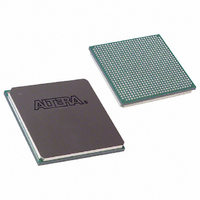EP1S20F780I6N Altera, EP1S20F780I6N Datasheet - Page 135

EP1S20F780I6N
Manufacturer Part Number
EP1S20F780I6N
Description
IC STRATIX FPGA 20K LE 780-FBGA
Manufacturer
Altera
Series
Stratix®r
Specifications of EP1S20F780I6N
Number Of Logic Elements/cells
18460
Number Of Labs/clbs
1846
Total Ram Bits
1669248
Number Of I /o
586
Voltage - Supply
1.425 V ~ 1.575 V
Mounting Type
Surface Mount
Operating Temperature
-40°C ~ 100°C
Package / Case
780-FBGA
Family Name
Stratix
Number Of Logic Blocks/elements
18460
# I/os (max)
586
Frequency (max)
450.05MHz
Process Technology
0.13um (CMOS)
Operating Supply Voltage (typ)
1.5V
Logic Cells
18460
Ram Bits
1669248
Operating Supply Voltage (min)
1.425V
Operating Supply Voltage (max)
1.575V
Operating Temp Range
-40C to 100C
Operating Temperature Classification
Industrial
Mounting
Surface Mount
Pin Count
780
Package Type
FC-FBGA
Lead Free Status / RoHS Status
Lead free / RoHS Compliant
Number Of Gates
-
Lead Free Status / Rohs Status
Compliant
Available stocks
Company
Part Number
Manufacturer
Quantity
Price
Company:
Part Number:
EP1S20F780I6N
Manufacturer:
ALTERA
Quantity:
3 000
- Current page: 135 of 864
- Download datasheet (11Mb)
Altera Corporation
July 2005
and/or output enable registers. A programmable delay exists to increase
the t
Table 2–24
The IOE registers in Stratix devices share the same source for clear or
preset. You can program preset or clear for each individual IOE. You can
also program the registers to power up high or low after configuration is
complete. If programmed to power up low, an asynchronous clear can
control the registers. If programmed to power up high, an asynchronous
preset can control the registers. This feature prevents the inadvertent
activation of another device’s active-low input upon power-up. If one
register in an IOE uses a preset or clear signal then all registers in the IOE
must use that same signal if they require preset or clear. Additionally a
synchronous reset signal is available for the IOE registers.
Double-Data Rate I/O Pins
Stratix devices have six registers in the IOE, which support DDR
interfacing by clocking data on both positive and negative clock edges.
The IOEs in Stratix devices support DDR inputs, DDR outputs, and
bidirectional DDR modes.
When using the IOE for DDR inputs, the two input registers clock double
rate input data on alternating edges. An input latch is also used within the
IOE for DDR input acquisition. The latch holds the data that is present
during the clock high times. This allows both bits of data to be
synchronous with the same clock edge (either rising or falling).
Figure 2–65
the DDR input timing diagram.
Input pin to logic array delay
Input pin to input register delay
Output pin delay
Output enable register t
Output t
Output clock enable delay
Input clock enable delay
Logic array to output register delay
Output enable clock enable delay
Table 2–24. Stratix Programmable Delay Chain
ZX
Programmable Delays
delay to the output pin, which is required for ZBT interfaces.
ZX
delay
shows the programmable delays for Stratix devices.
shows an IOE configured for DDR input.
CO
delay
Decrease input delay to internal cells
Decrease input delay to input register
Increase delay to output pin
Increase delay to output enable pin
Increase t
Increase output clock enable delay
Increase input clock enable delay
Decrease input delay to output register
Increase output enable clock enable delay
Stratix Device Handbook, Volume 1
Quartus II Logic Option
ZX
delay to output pin
Figure 2–66
Stratix Architecture
shows
2–111
Related parts for EP1S20F780I6N
Image
Part Number
Description
Manufacturer
Datasheet
Request
R

Part Number:
Description:
CYCLONE II STARTER KIT EP2C20N
Manufacturer:
Altera
Datasheet:

Part Number:
Description:
CPLD, EP610 Family, ECMOS Process, 300 Gates, 16 Macro Cells, 16 Reg., 16 User I/Os, 5V Supply, 35 Speed Grade, 24DIP
Manufacturer:
Altera Corporation
Datasheet:

Part Number:
Description:
CPLD, EP610 Family, ECMOS Process, 300 Gates, 16 Macro Cells, 16 Reg., 16 User I/Os, 5V Supply, 15 Speed Grade, 24DIP
Manufacturer:
Altera Corporation
Datasheet:

Part Number:
Description:
Manufacturer:
Altera Corporation
Datasheet:

Part Number:
Description:
CPLD, EP610 Family, ECMOS Process, 300 Gates, 16 Macro Cells, 16 Reg., 16 User I/Os, 5V Supply, 30 Speed Grade, 24DIP
Manufacturer:
Altera Corporation
Datasheet:

Part Number:
Description:
High-performance, low-power erasable programmable logic devices with 8 macrocells, 10ns
Manufacturer:
Altera Corporation
Datasheet:

Part Number:
Description:
High-performance, low-power erasable programmable logic devices with 8 macrocells, 7ns
Manufacturer:
Altera Corporation
Datasheet:

Part Number:
Description:
Classic EPLD
Manufacturer:
Altera Corporation
Datasheet:

Part Number:
Description:
High-performance, low-power erasable programmable logic devices with 8 macrocells, 10ns
Manufacturer:
Altera Corporation
Datasheet:

Part Number:
Description:
Manufacturer:
Altera Corporation
Datasheet:

Part Number:
Description:
Manufacturer:
Altera Corporation
Datasheet:

Part Number:
Description:
Manufacturer:
Altera Corporation
Datasheet:

Part Number:
Description:
CPLD, EP610 Family, ECMOS Process, 300 Gates, 16 Macro Cells, 16 Reg., 16 User I/Os, 5V Supply, 25 Speed Grade, 24DIP
Manufacturer:
Altera Corporation
Datasheet:












